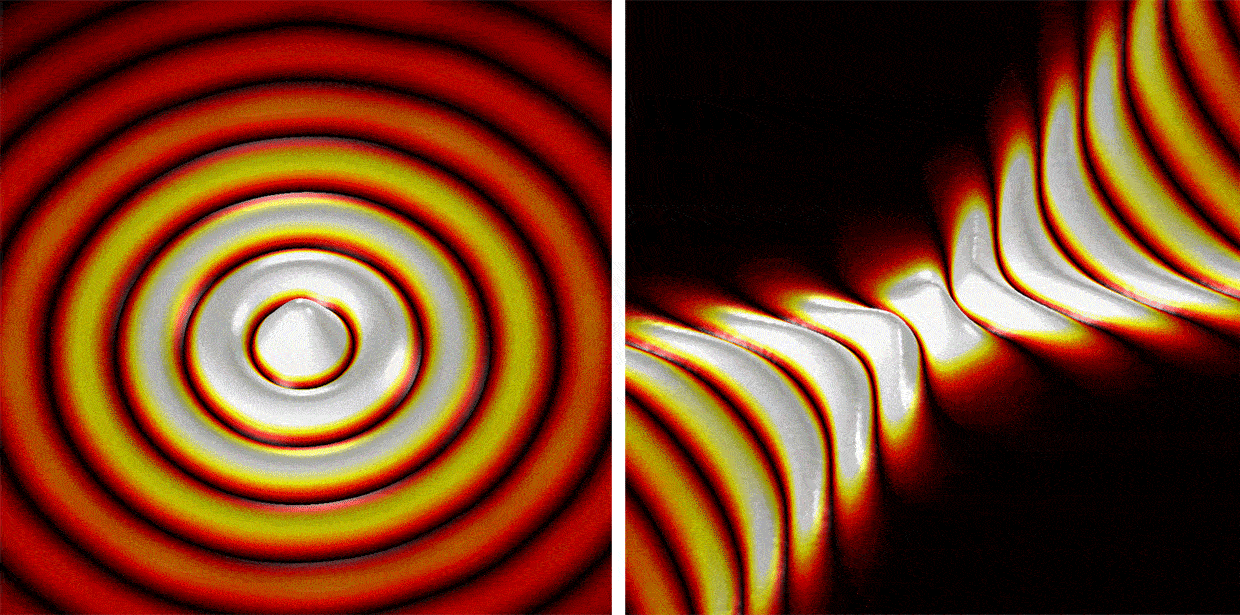Researchers from CIC nanoGUNE in Spain in collaboration with the Donostia International Physics Center (DIPC) along with Kansas State University have developed a real-world version of what theorists had dubbed a “hyperbolic metasurface.”
In these strange materials, light propagates with completely reshaped wavefronts than in typical surfaces, even other metasurfaces. The researchers believe that this new metasurface will enable greater control over light so that it can be used for creating increasingly smaller devices.
Metasurfaces enable the shortening of wavelengths of light below the diffraction limit, making it possible to design chip-sized devices that can manipulate light for information processing as well as shrink the sizes of devices based on traditional optics.
Traditionally, in these metasurfaces optical waves propagate away from the light source in circular and convex wavefronts—like the waves in a lake when a stone is thrown into it. The reason for this circular propagation of the wavefronts has to do with the medium they are traveling through. This uniformity in all directions means that the material is homogenous and isotropic.
Theories have predicted that one could structure the surface of a material so it would alter the propagation of these wavefronts. These surfaces—dubbed hyperbolic metasurfaces—would only allow the waves to travel in certain directions (not uniformly in all directions) and travel in concave (as opposed to convex) wavefronts.
These strange wavefronts are called hyperbolic surface polaritons. Polaritons are quasiparticles that are part light (a photon) and part matter (an electron-hole pair, also known as an exciton) and are generated when light strikes particular types of material. Because the hyperbolic surface polaritons can be directed to propagate in specific directions—rather than in all directions—many have speculated that their development should help to further miniaturize optical devices for sensing and signal processing.
To achieve their real-world version of these hyperbolic metasurfaces, the researchers used hexagonal boron nitride (hBN). Four years ago, we covered research that demonstrated that when light strikes hBN it creates tunable ripples, known as phonon polaritons. In that work, polaritons propagate isotropically along the hBN flake. In other words: they propagate with in-plane isotropy.
In this most recent research described in the journal Science, the Spanish researchers departed from this previous work by fabricating a grating out of hBN that essentially broke the in-plane symmetry along the surface.
“The optical properties are different for the directions parallel and perpendicular to the hBN nanoribbons that form the grating,” Rainer Hillenbrand, a professor at nanoGUNE and the leader of the Nanoptics Group told IEEE Spectrum. “The phonon polaritons now no longer propagate isotropically. In some directions they do not propagate at all.”
Essentially, what Hillenbrand and his colleagues have done is create an anisotropic surface in which the physical properties differ according to the directions you are measuring—an example of this would be wood where with the grain it is quite strong and against the grain it is quite weak. With this anisoptropic surface the wavelengths of the polaritons are allowed to only go in certain directions.
The aim of all this is to manipulate light so that it is much smaller than the wavelength of photons. For example, an infrared polariton wavelength can be up to 100 times smaller than the photon wavelength of the same energy.
“What comes along with this shorter wavelength is a concentration and confinement of the infrared fields and thus energy,” said Hillenbrand. “The combination of the two effects could be used to improve the sensitivity of infrared spectroscopy or to create ultra-small chips in which infrared light can be manipulated.”
Hillenbrand foresees that this could be applied to nanoscale management of thermal radiation, the development of ultra-small infrared spectrometers, or eventually for performing signal processing functions with infrared light.
With the metasurface, Hillenbrands believes they have created a platform where the polaritons propagate with even stronger confinement (compared to the unstructured surface) and in a very peculiar way.
For example, it’s possible that they could achieve directional propagation with this material, according to Hillenbrand. In addition, the wavelength of the polaritons depends on the direction they are traveling.
In this arrangement, the interference of the directional waves leads to the counterintuitive concave wavefronts of a diverging beam. In addition, the interference of these directional waves could be adjusted such that polaritons from a point-like source propagate away in the form of extremely narrow beams.
Hillenbrand added: “This could enable directional infrared energy exchange between two places/objects located on the metasurface. Such energy exchange could be used for controlling heat on the surface or for transporting information/signals.”
Dexter Johnson is a contributing editor at IEEE Spectrum, with a focus on nanotechnology.



